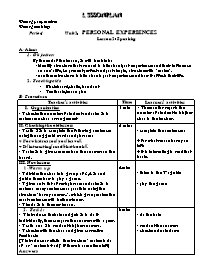Bài soạn môn học Tiếng Anh lớp 11 - Unit 2: Personal experiences - Lesson 2: Speaking

A- Aims:
1. Objectives:
By the end of the lesson, Ss will be able to:
- identify structures that are used to talk about past experiences and their influences on ones life, i.e present perfect and past simple, structure with “make”.
- use these structures to talk about a past experience and how it affects their life.
2. Teaching aids:
- Blackboard, chalk, handouts
- Textbook, lesson plan
B- Procedure:
Bạn đang xem tài liệu "Bài soạn môn học Tiếng Anh lớp 11 - Unit 2: Personal experiences - Lesson 2: Speaking", để tải tài liệu gốc về máy bạn click vào nút DOWNLOAD ở trên
Lesson plan Date of preparation: Date of teaching: Period: Unit 2: Personal experiences Lesson 2: Speaking A- Aims: Objectives: By the end of the lesson, Ss will be able to: - identify structures that are used to talk about past experiences and their influences on one’s life, i.e present perfect and past simple, structure with “make”. - use these structures to talk about a past experience and how it affects their life. Teaching aids: Blackboard, chalk, handouts Textbook, lesson plan B- Procedure: Teacher’s activities Time Learners’ activities Organization: - T checks the number of students and asks Ss to make some class arrangement. 1 min - The monitor reports the number of students in his/her class to the teacher. II. Checking the old lesson: - T calls 2 Ss to complete the following sentences using the suggested words and phrases: + For what reason/ you/ leave//. + It/ interesting/ read/ that book//. - T asks Ss to give comments on the answers on the board. 5 mins - complete the sentences: + for what reason have you left. + it is interesting to read that book. III. New lesson: 1- Warm- up: - T divides the class into groups of 3 ,4 Ss and guides them how to play a game. - T gives out a list of verb phrases and asks Ss to make as many sentences as possible using the structure “have you ever..”. which group makes the most sentences will be the winner. - T leads Ss to the new lesson. 4mins - listen to the T’s guide - play the game 2. Task 1: - T introduces the task and gets Ss to do it individually, then compare the answers with a peer. - T calls on a S to read out his/ her answers. - T checks with the class and gives corrective feedback. (T introduces or elicits the structure “ make sb do st” or “ make sb + adj” if there is some time left) Answers: 1. d, 2. c, 3. a, 4. d, 5. e 8mins - do the task - read out the answers - check and note down Task 2: - T asks Ss to 1 student to read out the requirement of the task. - T explains more to make it clearer. - T asks Ss to work individually on the sequence of the conversation and then find a peer to compare their answers with. - T goes around, control, and help. - T calls on a S to read out his/ her answers. - T checks with the class and gives corrective feedback. - T gets Ss to practise the sample conversation in closed and open pairs. Answers: 3. h, 4. a, 5. e, 6. g, 7. c, 8. f 10mins - read out - listen - work individually. - listen - practise Task 3: - T asks 1 student to read out the requirement of the task. - T explains more about the requirement to make it clearer. - T gets Ss to work in pairs to have a conversation. In the meantime, T goes around to check and offer help. - T calls on some pairs to perform their conversations in front of the class. - T elicits feedback from the class and gives final comments. 12mins - read the requirement - listen - work in pairs - perform their conversations - listen IV- Consolidation: T interviews Ss the following questions to check their comprehension: - Have you ever climbed a mountain? - When did you climb and who did you climb with? ......................... 4mins - answer the T’s questions .............................. ........... V- Homework: - T assigns homework. 1min - do the homework VI – Feedback Strong points: .......................................................................... Weak points: ..........................................................................
Tài liệu đính kèm:
 Speaking2.doc
Speaking2.doc





